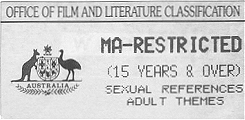
eBriefs
Computer
Games - Interactive Movies - Players
- Stakeholders -
Local
Censorship - Overseas Censorship - Developer
Responses - Accusations

 How are computer games censored in Australia?
How are computer games censored in Australia?
Although computer games have
been played in this country since at least the 1980s, it was only in the
1990s that people began to consider the idea of classifying these increasingly
popular and realistic products. In May of 1993, Labor Senator Margaret
Reynolds, horrified by the realistic computer game Night
Trap, began to actively campaign
for a system to regulate these products. By October, her influential
Senate
Select Committee on Community Standards Relevant to the Supply of Services
Utilising Electronic Technologies released a highly critical report
on computer games based largely on anecdotal evidence and conjecture -
the Report on Video and Computer Games
and Classification Issues - that firmly recommended their harsher
regulation than for film.
A further report by the Senate
Committee in 1994 - the Report on Overseas
Sourced Audiotex Services, Video and Computer Games, R-Rated Material on
Pay TV - reiterated many of its earlier findings on computer games.
Both sides of the House of Representatives praised the new Classification
(Publications, Films and Computer Games) Bill as rightly following
all the Senate Committee's recommendations. Newly developed computer
games classification guidelines banned almost all forms of sex and
nudity in computer games available in Australia.
The following year, the new
Classification Act came into force and allowed Federal classification decisions
to be rigorously enforced at the State level such as by Queensland's
Classification of Computer Games and Images (Interim) Act.
The first major, popular game from overseas, Phantasmagoria,
was Refused Classification and thus banned to all Australians. Similar
decisions that prevented all Australians from accessing popular computer
games from overseas were soon to follow.
All actions taken by Australian
governments to regulate the sale and distribution of computer games were
inspired by universal agreement with two key recommendations that arose
from the Senate Committee's 1993 Report:
Recommendation number six
on page vi stated:
Having regard to the
extra sensory intensity involved in the playing of interactive games and
the implications of long-term effects on users, the Committee recommends
that stricter criteria for classification than those applying to equivalent
film and video classifications be set by [classification] authorities...
Recommendation number four
on page v supported number six by proclaiming:
The Committee is concerned
that the level of technology involved with the use of ... computer games
means that many parents do not necessarily have the competency to ensure
adequate parental guidance. Therefore the Committee recommends that
material of an 'R' equivalent category be refused classification.
The Committee also recommends that if an 'X' equivalent classification
is considered it should not be adopted for ... computer games material...
In other words, it was heavily
implied that children are the only players of
computer games (or at least comprise the vast majority of players),
and that parents do not play them, and, in fact, have very low computer
competency. As a compounding factor to lead to severe regulation,
computer games were deemed to be of greater impact on users due to their
"extra-sensory intensity" in comparison to film.
Resulting
from these beliefs were the Office of Film
and Literature Classification's (OFLC) 1994 computer
games classification guidelines which remain in force today.
The OFLC is a Federal Government agency located within the Attorney General's
Department that is primarily responsible for classifying all films (including
videos) and computer games made available for sale or hire to the public
in Australia. Using official, periodically
reviewed guidelines, these products are assigned ratings according
to their suitability to certain age groups and many are additionally provided
with consumer advice giving a very brief summary of the reasons for the
rating.
Current ratings for computer
games (in order of level of restriction, least restrictive first) = G (all
ages), G 8+, M 15+, MA 15+, RC (Refused Classification). For films
= G, PG, M 15+, MA 15+, R 18+, X 18+ (video only), RC. Products refused
classification may not be sold or hired in Australia.
Aside from allowing for significantly
fewer ratings than for film, the computer games ratings most notably exclude
all non-medical instances of sex or nudity (real or simulated, whether
using animated figures or real human actors, and regardless of context
or plot requirements) from computer games made available in this country.
This is in stark contrast to the far more liberal attitude taken under
the film classification guidelines which allow for such material from as
low as the PG or M 15+ ratings.


An example of an OFLC classification sticker for the highest legal
rating for computer games (MA 15+). Brief reasons for the rating
are provided in the form of associated consumer advice.


The OFLC operates from a relatively small, secluded building located
in an alleyway a couple of kilometres from Sydney's CBD. They occupy
the top two levels. Overly inquisitive visitors are not welcome on
level 6! Both levels are high security areas (e.g. photography is
banned and one can see security coded doors, small reception areas, and
very small reception desks).
Further
details of my visit to the censorsCurrent members (censors) of the OFLC's Classification Board
Information on the newly appointed OFLC Classification Board members


